When Brands Are Pulled Into Tragedy: How Peak Design Navigated Misinformation & Reputational Crisis.
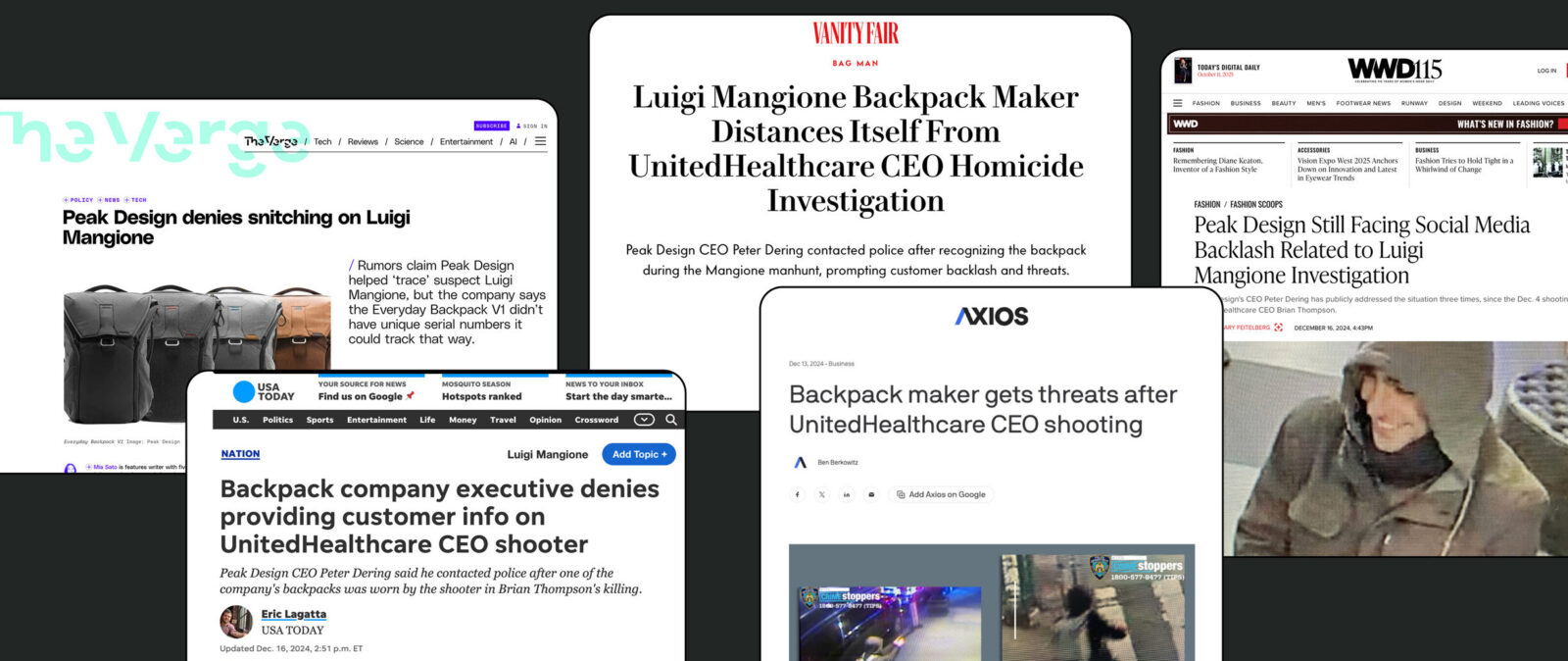
Introduction
When Brands Are Pulled Into Tragedy: How Peak Design Navigated Misinformation & Reputational Crisis.
What We Did
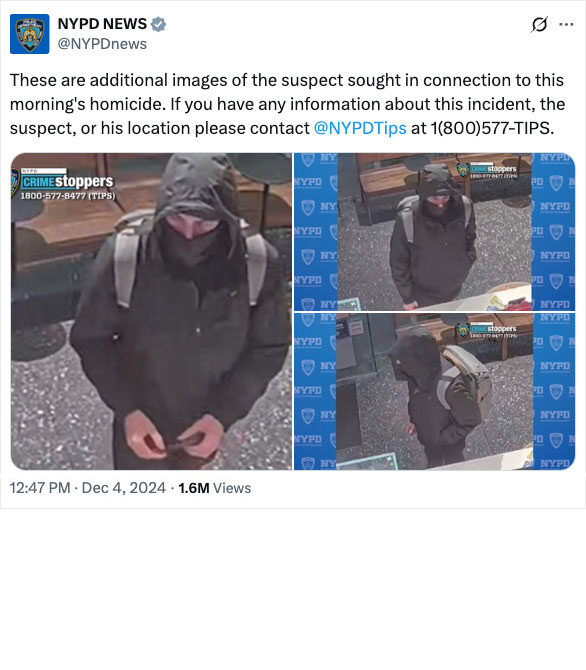
In early December 2024, news broke of the shocking shooting of UnitedHealthcare CEO Brian Thompson. As details unfolded, one of the few early leads about the mysterious shooter, later identified as Luigi Mangione, was that he was wearing “a distinctive backpack” that was instantly recognizable as a Peak Design Everyday Backpack.
What followed was a wave of unprecedented brand attention. The morning of Dec 5, 2024, Peak Design CEO + Founder, Peter Dering, woke up to a barrage of text messages informing him that the alleged shooter was wearing one of his backpacks. Soon thereafter, the New York Times called and Dering shared that he had, in good faith, called the tip line and confirmed that the shooter was indeed wearing a Peak Design backpack in surveillance photos released by the New York Police Department.
Although Dering was one of hundreds who called in the same tip, immediately, rumors circulated that Peak Design had shared customer data with law enforcement, and suddenly, the brand became part of a dark national conversation around extrajudicial killings, the healthcare system, and corporate distrust.
Unfounded claims began to circulate across social media that Peak Design had cooperated with law enforcement, tracked down the suspect using a serial number, and disclosed customer information.
The Fallout
The rumor mill intensified rapidly as misinformation spread over social media. Peak Design faced a wave of public confusion and, in some cases, backlash.
- Targeted harassment and threats directed at company staff.
- Customer concern over data privacy and product registration.
- Calls for boycotts among fringe groups sympathetic to the suspect.
- A surge in misinformation about the company’s involvement in the case.
The situation represented a reputational stress test for a brand built on a loyal user base and a strong ethical identity.
Crisis Management
When it became clear that the issue needed to be addressed directly, the Purple Orange team set up social and media monitoring and helped Peak Design craft a public statement and customer service response to privacy concerns. We also fought misinformation online by removing fake Google Reviews and social media comments. Finally, we felt it was in the best interest of Peak Design employees’ safety to temporarily close brand stores in the immediate aftermath of the event.
1. Rapid Situation Assessment.
The initial response began with a three-person internal group chat that quickly evolved into a 15-person cross-functional Slack channel. The team worked to:
- Align on facts surrounding the New York Times interview and public perception.
- Track social sentiment, retail inquiries, and ambassador questions in real time.
- Review privacy policies, registration data procedures, and internal statements to ensure absolute accuracy.
- Use media and social monitoring tools to gauge reach, tone, and sentiment across media.
2. Controlling Communications Channels.
To slow the spread of misinformation, Peak Design immediately:
- Disabled social comments on all platforms.
- Paused paid advertising and declined further media interviews.
- Consolidated communications under one consistent voice to avoid mixed messaging.
3. Developing a Response.
Crafting the public statement became the most challenging and sensitive phase. Every word was carefully debated to balance empathy, honesty, and restraint while maintaining credibility. The team’s guiding principles were: Clarity. Transparency. Honesty. Trust. Timeliness.
While the early response suffered from too many cooks in the kitchen, the final statement clearly articulated Peak Design’s privacy policy—affirming that no customer data was provided and that identifying information would only be shared under subpoena. It also contextualized the company’s use of product serial numbers and registration data.
4. Controlling the Narrative.
The statement was distributed across all owned channels, including the company blog, social media, newsletter, and internal networks. All inquiries—from media, ambassadors, and retailers—were directed back to this unified source of truth.
Daily reports provided real-time tracking of:
- Media sentiment (Positive / Neutral / Negative).
- Coverage reach and social trends.
- Tone shifts within Peak Design’s core customer base.
Within weeks, sentiment began to normalize. The team’s rapid response, transparency, and control of the narrative was later recognized and praised by PR Daily.
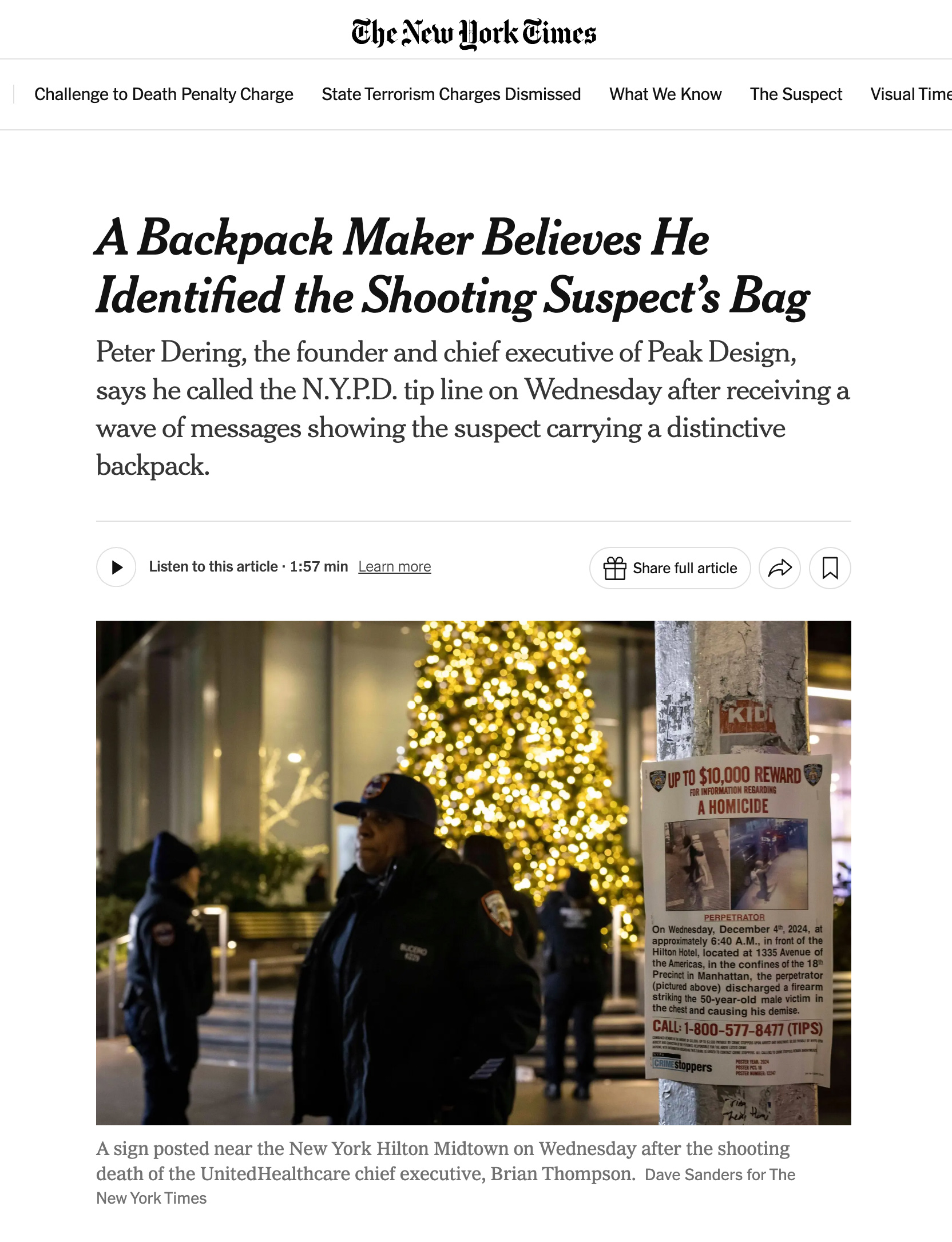
Front Page of the NYTimes.
Quickly, the public and the media latched onto the shooter’s backpack — a “distinctive” model made by Peak Design. From here, a positive identification by the company’s CEO led to the investigation’s first meaningful tip, and a vicious social media response filled with misinformation about the brand’s privacy policies.
Peak Design's Response.
Correcting misinformation was paramount, but the brand also didn’t want to get pulled into the moral conversation happening around healthcare and the groundswell of interest in the shooter.
There were those who resorted to trolling and threatening the brand. However, Peak Design’s primary focus remained on its loyal customers and reassuring them how and why the company utilizes customer information — to inform of product recalls.
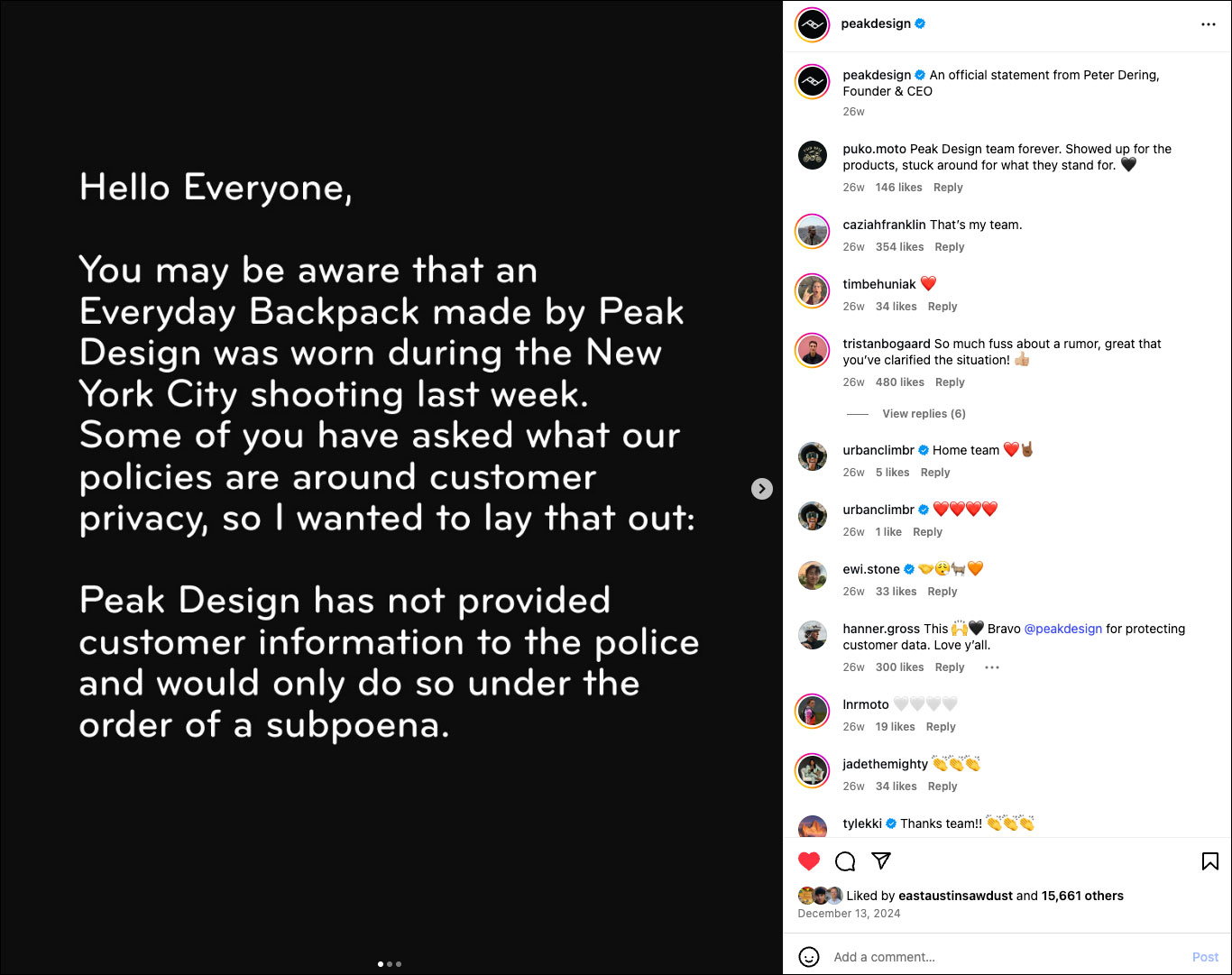
Public and Media Reaction
Peak Design’s response drew notable media attention and a generally supportive tone from industry and mainstream press alike. Coverage appeared in GearJunkie, The Verge, Vanity Fair, Axios, WWD, and PRNews, with most outlets helping to counter false claims and contextualize the company’s actions.
While some online backlash persisted—particularly from fringe groups sympathetic to the shooter—core customers and industry observers viewed Peak Design’s handling as measured, factual, and transparent.
Public trust gradually returned as misinformation subsided, and the company’s consistent tone of honesty and restraint was widely seen as a case study in responsible crisis management.
The crisis ultimately led to a reaffirmed public commitment to data privacy and responsible communication, prompting Peak Design to strengthen its internal protocols for managing high-risk public exposure. It also created an opportunity to educate audiences, resulting in a broader public understanding of how the company handles product registration and warranty data.
Lessons Learned.
Other brands entangled in the tragedy escaped almost entirely unscathed (and arguably their tides rose) as a result of staying completely out of the crisis. No interviews, no comment.
For future crises, early alignment on executive communications strategy will be crucial to mitigating unexpected backlash. Once Peak Design was drawn into the conversation, however, speed and precision became paramount.
By refusing to engage with the “snitching” narrative and focusing solely on correcting factual inaccuracies, the company regained control of the story. Roughly a month after issuing its public statement, Peak Design returned to social media as the controversy had largely faded, illustrating how disciplined restraint, factual transparency, and patience can outlast even the most volatile online storm.
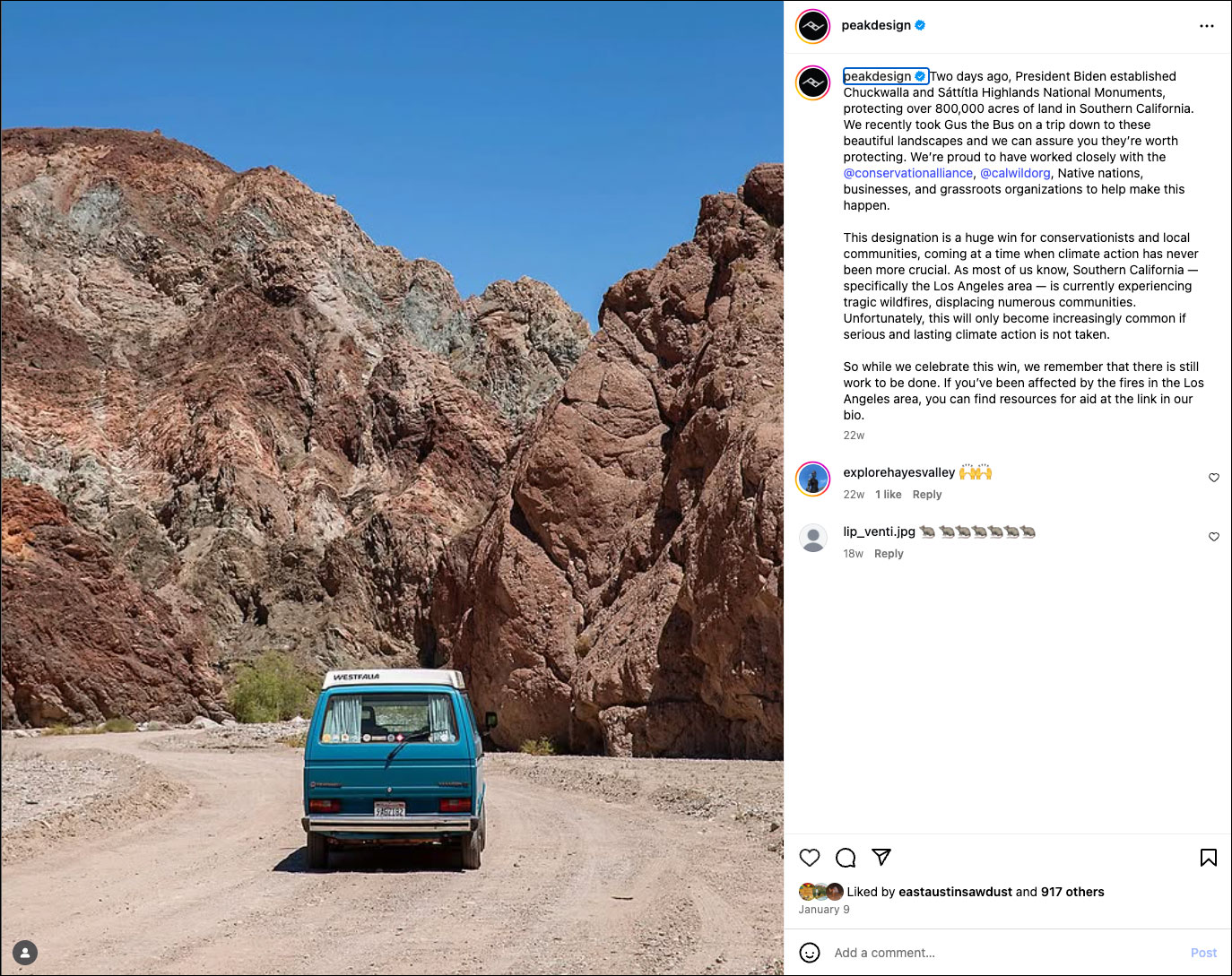
Social Reimergence
Peak Design re-emerged on social media nearly 1 month after their public statement. By then, the matter was put in the rearview… mostly.